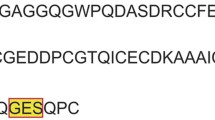Summary
-
1.
Crotoxin, the crystallizable, proteinaceous, approximately electroneutral fraction from the venom ofCrotalus durissus terrificus, has been resolved further by chromatography on carboxymethyl cellulose. We obtained:
-
a)
A basic phospholipase A with comparatively low toxicity in mice (LD50 i.v. 0.54 mg/kg; LD50 s.c. > 100 mg/kg), whereas the toxicity of crotoxin was 0.108 mg/kg i.v. and 0.50 mg/kg s.o., respectively. In contrast, the specific enzymatic activity of phospholipase A was about 4 times higher than in crotoxin, depending on the dosage used. Overall recovery of activity was 140% to 170%, which suggests the removal of an inhibitor.
-
b)
An acidic substance (“Crotapotin”)1 devoid of toxicity (LD50 i.v. > 50 mg/kg, mice) and phospholipase activity.
-
c)
A mixture (called fraction III) of phospholipase A, crotapotin and a third basic substance. The latter, being inactive in our tests, is present in small amounts only (about 1% of crotoxin).
-
2.
Recombination of crotapotin with phospholipase A increases the i.v. toxicity of phospholipase A approximately 12 fold to 0.042 mg/kg; the s.c. toxicity of the enzyme is raised approximately 1000 fold to 0.13 mg/kg.
-
3.
In contrast to potentiating the phospholipase toxicity, crotapotin strongly inhibits the enzymatic activity in vitro.
-
4.
These findings help in explaining the former reports on the chemical heterogeneity of crotoxin and on the preparation of toxic compounds with low phospholipase activity from it. Crotoxin is to be considered as a complex consisting of phospholipase A, crotapotin, and small amounts of impurities.
Similar content being viewed by others
References
Breithaupt, H., Rübsamen, K., Walsch, P., Habermann, E.: In vitro and in vivo interactions between phospholipase A and a novel potentiator isolated from socalled crotoxin. Naunyn-Schmiedebergs Arch. Pharmak. (in press).
Fraenkel-Conrat, H., Singer, B.: Fractionation and composition of Crotoxin. Arch. Biochem.60, 64–73 (1956).
Habermann, E.: Beiträge zur Pharmakologie von Phospholipase A. Naunyn-Schmiedebergs Arch. exp. Path. Pharmak.230, 538–546 (1957a).
—: Gewinnung und Eigenschaften von Crotactin, Phospholipase A, Crotamin und „Toxin III“ aus dem Gift der brasilianischen Klapperschlange. Biochem. Z.329, 405–415 (1957b).
—: Manometrische Bestimmung von Phospholipase A. Biochem. Z.328, 474–484 (1957c).
—: Biochemie, Pharmakologie und Toxikologie der Inhaltsstoffe von Hymen-opterengiften. Rev. Physiol. Biochem. exp. Pharmacol.60, 220–325 (1968).
—, Neumann, W.: Die Hemmung der Hitzekoagulation von Eigelb durch Bienen-gift — ein Phospholipase-Effekt. Hoppe-Seylers Z. physiol. Chem.297, 179–193 (1954).
—, Rübsamen, K.: Biochemical and pharmacological analysis of the so-called crotoxin. In: de Vries/Kochva (Ed.): Toxins of animal and plant origin, pp. 333–341. London: Gordon and Breach 1971.
Hendon, R., Roy, D., Fraenkel-Conrat, H.: Can rattlesnake neurotoxin and phospholipase be separated ? Toxicon8, 135 (1970).
Litchfield, J. T., Wilcoxon, F.: A simplified method of evaluating dose-effect experiments. J. Pharmacol. exp. Ther.96, 99–113 (1949).
Maurer, H. R.: Disk-Elektrophorese. Berlin: W. de Gruyter u. Co. 1968.
Neumann, W. P., Habermann, E.: Über Crotactin, das Haupttoxin des Giftes der brasilianischen Klapperschlange (Crotalus terrificus terrificus). Biochem. Z.327, 170–185 (1955).
Slotta, K. H.: Zur Chemie der Schlangengifte. Experientia (Basel)9, 81–120 (1953).
—: Chemistry and biochemistry of snake venoms. Fortschr. Chem. Org. Naturst.12, 406–465 (1955).
—, Fraenkel-Conrat, H. L.: Schlangengifte, III. Mitteilung: Reinigung und Krystal-lisation des Klapperschlangen-Giftes. Ber. dtsch. chem. Ges.71, 1076–1081 (1938).
Stockebrand, P.: Untersuchungen über Reinigung und Eigenschaften der Bienen-giftenzyme sowie zur Allgemeintoxizität von Phospholipase A im Vergleich zu Melittin. Inaug.-Diss., Würzburg (1965).
Author information
Authors and Affiliations
Rights and permissions
About this article
Cite this article
Rübsamen, K., Breithaupt, H. & Habermann, B. Biochemistry and pharmacology of the crotoxin complex. Naunyn-Schmiedebergs Arch. Pharmak. 270, 274–288 (1971). https://doi.org/10.1007/BF00997027
Received:
Issue Date:
DOI: https://doi.org/10.1007/BF00997027




